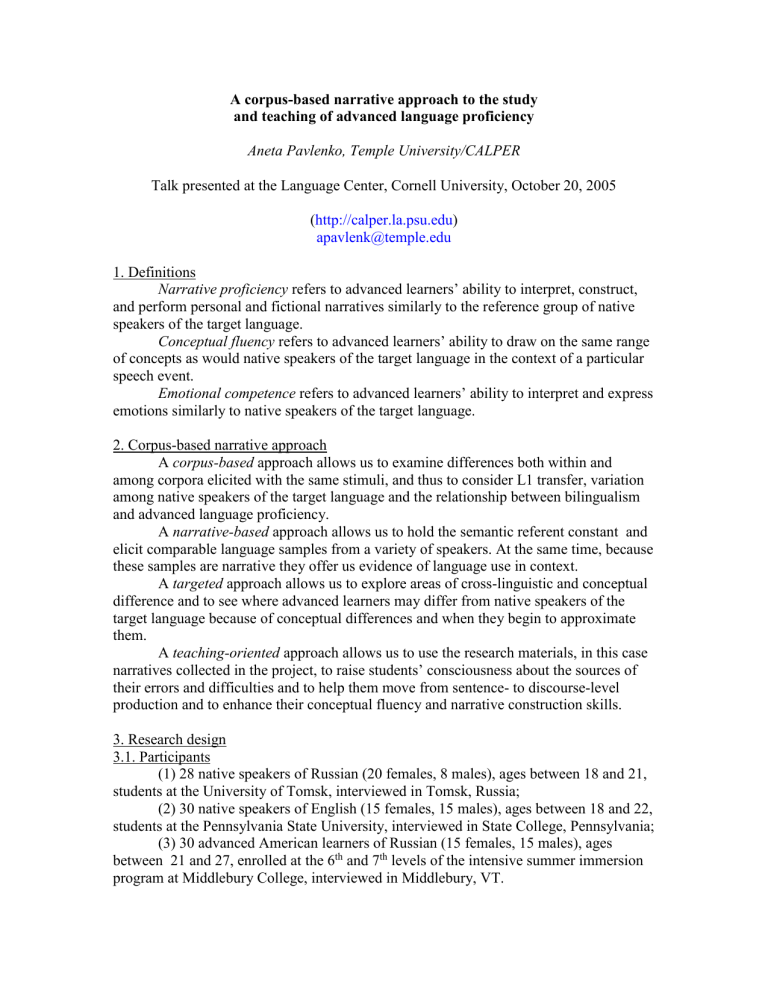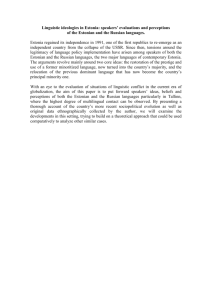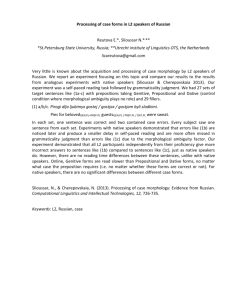handout - Language Resource Center

A corpus-based narrative approach to the study and teaching of advanced language proficiency
Aneta Pavlenko, Temple University/CALPER
Talk presented at the Language Center, Cornell University, October 20, 2005
( http://calper.la.psu.edu
) apavlenk@temple.edu
1. Definitions
Narrative proficiency refers to advanced learners’ ability to interpret, construct, and perform personal and fictional narratives similarly to the reference group of native speakers of the target language.
Conceptual fluency refers to advanced learners’ ability to draw on the same range of concepts as would native speakers of the target language in the context of a particular speech event.
Emotional competence refers to advanced learners’ ability to interpret and express emotions similarly to native speakers of the target language.
2. Corpus-based narrative approach
A corpus-based approach allows us to examine differences both within and among corpora elicited with the same stimuli, and thus to consider L1 transfer, variation among native speakers of the target language and the relationship between bilingualism and advanced language proficiency.
A narrative-based approach allows us to hold the semantic referent constant and elicit comparable language samples from a variety of speakers. At the same time, because these samples are narrative they offer us evidence of language use in context.
A targeted approach allows us to explore areas of cross-linguistic and conceptual difference and to see where advanced learners may differ from native speakers of the target language because of conceptual differences and when they begin to approximate them.
A teaching-oriented approach allows us to use the research materials, in this case narratives collected in the project, to raise students’ consciousness about the sources of their errors and difficulties and to help them move from sentence- to discourse-level production and to enhance their conceptual fluency and narrative construction skills.
3. Research design
3.1. Participants
(1) 28 native speakers of Russian (20 females, 8 males), ages between 18 and 21, students at the University of Tomsk, interviewed in Tomsk, Russia;
(2) 30 native speakers of English (15 females, 15 males), ages between 18 and 22, students at the Pennsylvania State University, interviewed in State College, Pennsylvania;
(3) 30 advanced American learners of Russian (15 females, 15 males), ages between 21 and 27, enrolled at the 6 th
and 7 th
levels of the intensive summer immersion program at Middlebury College, interviewed in Middlebury, VT.
3.2. Method
Four narratives were elicited from participants: three fictional narratives were elicited through visual stimuli and one personal narrative was elicited through a life story interview format.
5. Results
5.1. Russian and English emotion lexicons
- distribution of emotion terms across categories
- preferred pattern of emotion description: adjectival (English) versus verbal (Russian)
- subcategorization, in particular the use of copula verbs with emotion terms:
English: to look happy, to feel great Verb + Adj (Nom)
Russian: Verb + Adv; Verb + Adj (Inst); Pro (Dat) + Verb + Adv; Pro + Adv
- semantic differences in the meaning of translation equivalents (e.g., jealousy/
, envy/
) (cf. Stepanova & Coley, 2002)
- pragmatic differences (e.g.,
/to be angry at someone,
/to be hurt, offended) (cf. Wierzbicka, 2004)
- language- and culture-specific emotion terms and metaphors (e.g., fun,
)
5. Results: Evaluation and lexical selection through the lens of emotion vocabulary
Table 1. Emotion vocabulary in The Letter narratives
Word categories
Verbs
American monolinguals
18% (48)
Russian monolinguals
50% (67)
American learners
42% (76)
Adjectives 68% (184) 34% (45)
Nouns 10% (28) 14% (19)
34% (61)
9% (17)
Adverbs 4% (10) 2% (3) 15% (27)
5.1. Monolinguals’ narratives
The analysis revealed differences in the dominant patterns of emotion description: adjectival in English (68% of the whole corpus of emotion words) and verbal in Russian
(50% of the whole corpus of emotion words).
There was also a difference in the actual emotion terms most frequently used to describe the ‘same’ state: Russian speakers used two intransitive verbs, rasstraivat’sia and perezhivat’
, which worked in tandem in both monolingual corpora, while English
speakers favored an emotion adjective ‘upset’ with a range of copula verbs.
English speakers’ narratives:
(1) ... she was really frustrated, upset...
... she got really upset when she read the letter...
... she became very upset that her friend was looking through her mail...
Russian speakers’ narratives:
(2) Видимо, письмо не очень приятное, потому что девушка начинает расстраиваться, переживает... [It looks like the letter is not a very pleasant one, because the woman begins to be getting upset ( rasstraivat’sia ), worrying ( perezhivaet )]
…видимо, письмо было - печального содержания, потому что она сильно расстроилась. Ну, показано как она переживает... […perhaps the letter had some sad contents, because she got really upset ( rasstroilas’ ). So it shows how she is worrying ( perezhivaet )] прочитав это письмо она очень расстроилась. Видимо, там было неприятное известие. И сидя в своей комнате, размышляя, в общем она очень переживала. {Having read this letter, she got really upset ( rasstroilas’ ). Looks like it contained some unpleasant news. And sitting in her room, thinking, she was really worrying/suffering ( perezhivala )],
Чи/читая письмо, она расстраивается, видать, это была – не очень хорошая новость для нее, она очень расстроилась. [ Re, reading the letter, she is becoming upset ( rasstraivaetsia ), looks like it wasn’t good news for her, she got really upset ( rasstroilas’ )] по-видимому, письмо ее чем-то расстроило, она сидела переживала… [it looks like the letter upset ( rasstroilo ) her somehow, she was sitting suffering ( perezhivala )]
American learners’ of Russian narratives:
The analysis of emotion word choices in the students’ narratives suggests that advanced American learners of Russian use some of the same emotion words as native speakers of Russian when describing feelings ( rasstraivat’sia
, plakat’
, serdit’sia
) and that they also conform to the native Russian pattern in that they use more verbs (42%, 76 tokens) than adjectives (34%, 61 tokens) in their narratives. In fact, a few sound nativelike in the way they describe the protagonist’s feelings:
(3) она прочитала это письмо, кажется что в этом письме была какая-то плохая новость. Она заплакала, очень расстроилась... [she read the letter, it seems that the letter contained some bad news. She began crying, got very upset ( rasstroilas’ )] ясно что в нем что-то непри/неприятное… написано, ну потому что она сильно расстроилась. Она не заплакала, кажется, что она рассердилась… [it is clear that there is something unplea/unpleasant in it… written, because she got really upset ( rasstroilas’ ). She didn’t start crying, it seemed that she got angry…]
There were also six differences between native speakers of Russian and advanced
American learners of Russian:
(1) First of all, American students’ narratives offer evidence of systematic lexical choice difficulties in the area of emotion vocabulary seen in: (1) increased amount of pausing, hesitation, and false starts in sentences which describe the protagonist’s feelings,
(2) increased amount of laughter in the same context (commonly used to cover up the feeling of discomfort about one’s proficiency), (3) questions to the interviewer about the correct form and meaning of Russian emotion words ( ona rasserdilas’, da?
ona abitsa ? ona abilas’
?
Eto pravda, uteshit’ ee
?), (4) increased appeal to alternative means of emotional description, such as exaggerated intonation, body language, repetition ( ona plakala, plakala ), and direct speech (
Chto sluchilos’?
Pochemu tebe ploho?
), not used by native speakers of Russian in the context of this task.
(2) Second, several learners exhibited morphosyntactic transfer of the adjectival pattern from L1 English into L2 Russian:
(4) она была сердитой/сердита… [she was angry, angry (changing case endings)] она стала сердитой [she became angry] она ушла потому что она была очень сердитая мне кажется и очень грустная [she left because she was very angry, it seems to me, and very sad]
… она читала письмо и она стала очень грустной [she was reading the letter and she became very sad] другая женщина она не стала … грустной. Она выглядела как она сочуст/ сочуст/сочуствовала… другой женщине… [the other woman did not become … sad. She looked like she empathized … the other woman] первая девушка… (2.0) … ну вот как стала расстроена и она ушла [the first girl … (2.0) … so became upset ( rasstroena ) and she left]
(3) The third interesting result is the complete absence of the verb perezhivat’
, one of the two verbs that dominated the monolingual Russian corpora. This absence is not surprising: the verb rasstraivat’sia
has a corresponding adjective, rasstroennyi , that maps in the mental lexicon onto a familiar notion of getting ‘upset’, while the verb perezhivat’
has neither a structural, i.e. adjectival, nor semantic counterpart in English, and is thus harder to acquire.
(4) Fourth, compared to both speakers of English and Russian and to Russian-
English bilinguals, the learners appear to overuse emotion adverbs
(15% in the learners’ corpus as opposed to 2%-6% in the monolingual corpora and 5-9% in the bilingual corpus). There are two reasons for this overuse. The first one is L1 transfer, as adverbial constructions allow learners to use state and change-of-state verbs. The second reason is the emphasis on evaluative adverbs in Russian textbooks and in the classroom, where
learners are often prompted to talk about their own and others’ feelings, moods, and attitudes using adverbial constructions (e.g., mne grustno, mne stydno, mne skuchno ), which are indeed common in dialogic interactions:
(5) ей стала грустно… ей было ст/обидно [it became sad to her… it was hurtful to her] ей не было так счастливо [it was not so happy to her] очевидно ей очень плохо [it is clear that she is unwell] она читала одно письмо и это было очень грустно [she was reading a letter and it was very sad]
(5) The fifth difference between the two sets of narratives is in the sociolinguistic appropriacy of the lexical choices. The learners often appeal to choices sanctioned in their textbooks and classrooms that are either too literary or too strong for the context of this particular task, such as koshmar , uzhas ; they are also not too skilled in application of emotion metaphors:
(6) мне кажется что как сердце не разбило… [it seems to me that is like heart is not broken] для первую девушку открыть свою душу... [to open her soul to the first girl]
(6) Finally , we also see attempts at lexical borrowing where learners perceive lexical lacunae in their emotional vocabulary:
(7) может быть у нее была фрустрация какая-то, не знаю… [Maybe she had some frustration,
I don’t know] не просто грустнее но как что-то ее фрастрирует/фрастрировало… [Not simply sadder, but something is frustrating her, frustrated…]
Conclusions
(1) lack of attention to structural differences in dominant patterns of emotion description, which results in lexical choice difficulties and in the transfer of the adjectival pattern of emotion description from English into Russian, accompanied by violation of subcategorization constraints;
(2) lack of attention to language-specific semantic, pragmatic, and sociolinguistic properties of emotion vocabulary, which results in difficulties in describing people’s emotion states and feelings using appropriate vocabulary and an appropriate register;
(3) focus on dialogic interaction, which results in overuse of evaluative adverbs and in difficulties in producing third person descriptions.
Selected references
McCabe, A. & L. Bliss (2003) Patterns of narrative discourse: A multicultural, life span
approach . Boston, MA: Allyn and Bacon.
Pavlenko, A.
(2002a) Emotions and the body in Russian and English. Pragmatics and
Cognition , 10, 1-2, 201-236.
Pavlenko, A. (2002b) Bilingualism and emotions. Multilingua , 21, 1, 45-78.
Pavlenko, A. (2003) Eyewitness memory in late bilinguals: Evidence for discursive relativity. The International Journal of Bilingualism, 7, 3, 257-281.
Pavlenko, A. (in press) Narrative competence in a second language. In Byrnes, H.,
Weager-Guntharp, H. & K. Sprang (eds.) Educating for advanced foreign language capacities: Constructs, curriculum, instruction, assessment.
Georgetown University Roundtable On Languages and Linguistics 2005 .
Washington, DC: Georgetown University Press.
Pavlenko, A. (2005) Emotions and multilingualism . Cambridge University Press.
Rintell, E. (1990) That’s incredible: Stories of emotion told by second language learners and native speakers. In Scarcella, R., Andersen, E. & S. Krashen (eds.)
Developing communicative competence in a second language . Boston, MA:
Heinle & Heinle, pp. 75-94.
Wajnryb, R. (2003) Stories: Narrative activities in the language classroom . Cambridge
University Press.





